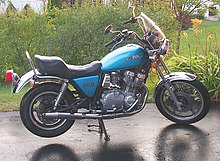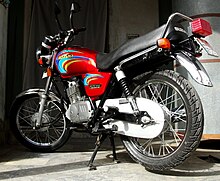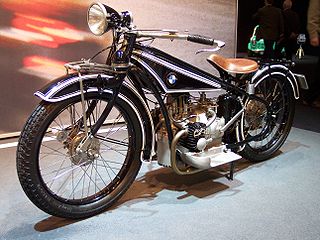
BMW's motorcycle history began in 1921 when the company commenced manufacturing engines for other companies. BMW's own motorcycles—sold under the BMW Motorrad brand—began in 1923 with the BMW R 32, which was powered by a flat-twin engine. Production of motorcycles with flat-twin engines continues to this day, however BMW has also produced many models with other types of engines.

Suzuki Motor Corporation is a Japanese multinational corporation headquartered in Minami-ku, Hamamatsu, Japan. Suzuki manufactures automobiles, motorcycles, all-terrain vehicles (ATVs), outboard marine engines, wheelchairs and a variety of other small internal combustion engines. In 2016, Suzuki was the eleventh biggest automaker by production worldwide. Suzuki has over 45,000 employees and has 35 production facilities in 23 countries, and 133 distributors in 192 countries. The worldwide sales volume of automobiles is the world's tenth largest, while domestic sales volume is the third largest in the country.

The Honda Gold Wing is a series of touring motorcycles manufactured by Honda. Gold Wings feature shaft drive and a flat engine. Characterized by press in September 1974 as "The world's biggest motor cycle manufacturer's first attack on the over-750cc capacity market...", it was introduced at the Cologne Motorcycle Show in October 1974.
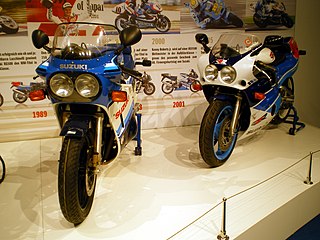
The Suzuki GSX-R is a series of sport bikes made by Japanese manufacturer Suzuki. Current models are the GSX-R125 and GSX-R150 since 2017; GSX-R600 which was manufactured from 1992 to 1993, and then since 1997; the GSX-R750 since 1985; and the GSX-R1000 since 2001.
The GSX Series is Suzuki's range of sport touring motorcycles powered by four-valve per cylinder four-stroke engines. The first GSX models were introduced in 1980 and represented the next step in Suzuki's four-stroke road bike range after the two-valve GS Series.

A sport bike is a motorcycle designed and optimized for speed, acceleration, braking, and cornering on asphalt concrete race tracks and roads. They are mainly designed for performance at the expense of comfort, fuel economy, and storage in comparison with other motorcycles.

The Suzuki Katana is a street motorcycle sold between 1981 and 2006 and then since 2019. It was designed in 1979–1980 by Target Design of Germany for Suzuki.

The Suzuki Bandit is a series of standard motorcycles produced by Suzuki since 1989. The Bandit series includes the following models:

A motorcycle engine is an engine that powers a motorcycle. Motorcycle engines are typically two-stroke or four-stroke internal combustion engines, but other engine types, such as Wankels and electric motors, have been used.

The BMW GS series of one purpose off-road/on-road BMW motorcycles have been produced from 1980, when the R80G/S was launched, to the present day. The GS refers to either Gelände/Straße or Gelände Sport. GS motorcycles can be distinguished from other BMW models by their longer travel suspension, an upright riding position, and larger front wheels – typically 19 to 21 inch. In May 2009, the 500,000th GS was produced, an R1200GS model.

The Suzuki GSX-R750 is a sports motorcycle made by Suzuki since 1985. It was introduced at the Cologne Motorcycle Show in October 1984 as a motorcycle of the GSX-R series.

The Suzuki GSX-R1000 is a supersport motorcycle made by Suzuki. It was introduced in 2001 to replace the GSX-R1100 and is powered by a liquid-cooled 999 cc (61.0 cu in) inline four-cylinder, four-stroke engine although originally 988 cc (60.3 cu in) from 2001 to 2004.
BMW Motorrad is the motorcycle brand and division of German automotive manufacturer, BMW. It has produced motorcycles since 1923, and achieved record sales for the fifth year in succession in 2015. With a total of 136,963 vehicles sold in 2015, BMW registered a growth of 10.9% in sales in comparison with 2014. In May 2011, the 2,000,000th motorcycle produced by BMW Motorrad was an R1200GS.

The Honda CBR1000F Hurricane is a sport touring motorcycle, part of the CBR series manufactured by Honda from 1987 to 1996 in the United States and from 1987 to 1999 in the rest of the world. It is powered by a liquid-cooled, DOHC, 998 cc (60.9 cu in), 16-valve inline-four engine. The CBR1000F, along with the CBR750F and CBR600F, was Honda's first inline four-cylinder, fully-faired sport bike.

The Suzuki GSX-R1100 is a sport bike from Suzuki's GSX-R series of motorcycles produced from 1986 until 1998.

MotoAmerica is the organization that promotes the AMA Superbike Series since 2015. Sanctioned by the American Motorcyclist Association (AMA) and the Fédération Internationale de Motocyclisme (FIM), it features six classes of road racing: Superbike, Stock 1000, Supersport, Twins Cup, Junior Cup, and Mini Cup.
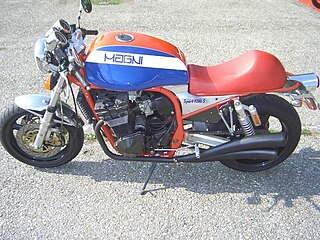
Magni is an Italian company that builds specialist motorcycles. The company is based in the city of Samarate in the province of Varese. Magni, in addition to building the bikes that bear its name, is also active in the construction of specials to order and a supplier of special parts for the restoration of MV Agusta classic motorcycles.
The 2020 MotoAmerica Championship was the 6th season of the MotoAmerica Championship.
